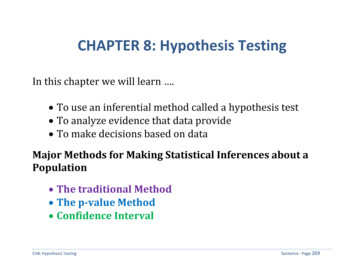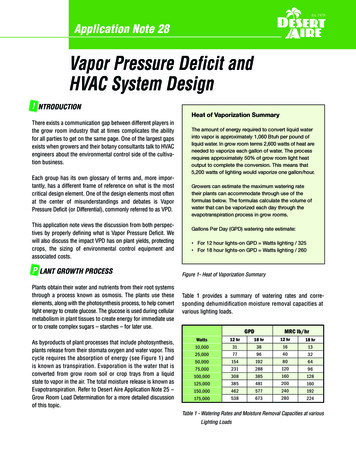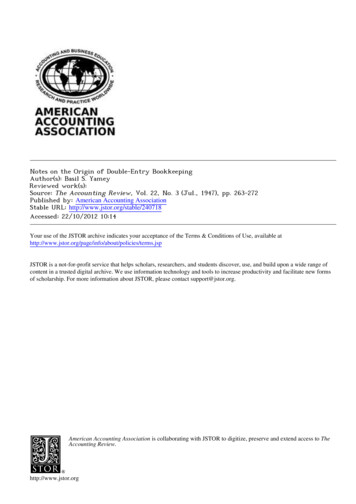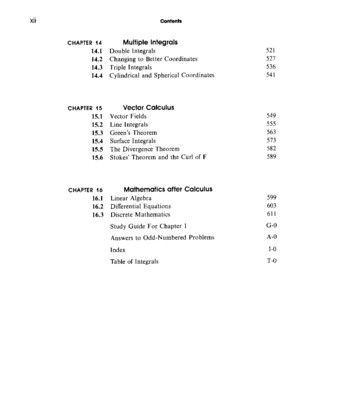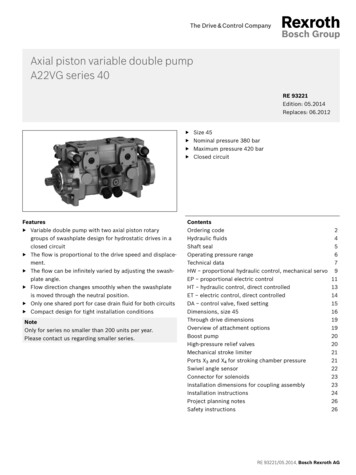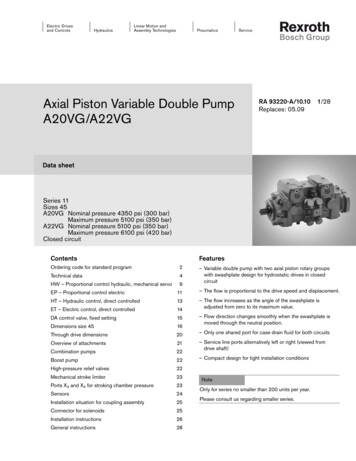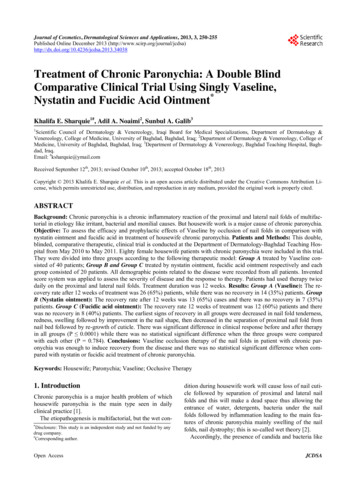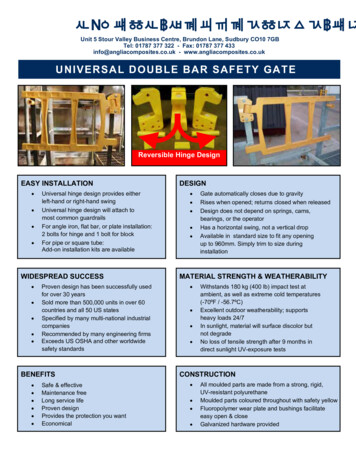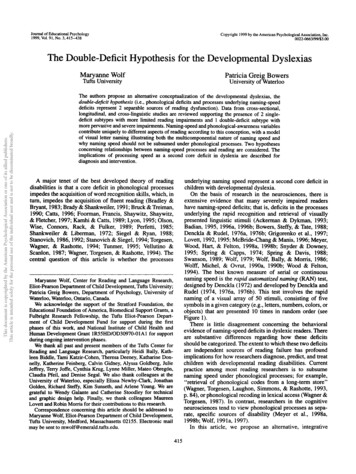
Transcription
Journal of Educational Psychology1999, Vol. 91, No. 3,415-438Copyright 1999 by the American Psychological Association, Inc.0022-0663/99/S3.00The Double-Deficit Hypothesis for the Developmental DyslexiasMaryanne WolfPatricia Greig BowersThis document is copyrighted by the American Psychological Association or one of its allied publishers.This article is intended solely for the personal use of the individual user and is not to be disseminated broadly.Tufts UniversityUniversity of WaterlooThe authors propose an alternative conceptualization of the developmental dyslexias, thedouble-deficit hypothesis (i.e., phonological deficits and processes underlying naming-speeddeficits represent 2 separable sources of reading dysfunction). Data from cross-sectional,longitudinal, and cross-linguistic studies are reviewed supporting the presence of 2 singledeficit subtypes with more limited reading impairments and 1 double-deficit subtype withmore pervasive and severe impairments. Naming-speed and phonological-awareness variablescontribute uniquely to different aspects of reading according to this conception, with a modelof visual letter naming illustrating both the multicomponential nature of naming speed andwhy naming speed should not be subsumed under phonological processes. Two hypothesesconcerning relationships between naming-speed processes and reading are considered. Theimplications of processing speed as a second core deficit in dyslexia are described fordiagnosis and intervention.A major tenet of the best developed theory of readingdisabilities is that a core deficit in phonological processesimpedes the acquisition of word recognition skills, which, inturn, impedes the acquisition of fluent reading (Bradley &Bryant, 1983; Brady & Shankweiler, 1991; Bruck & Treiman,1990; Catts, 1996; Foorman, Francis, Shaywitz, Shaywitz,& Fletcher, 1997; Kamhi & Catts, 1989; Lyon, 1995; Olson,Wise, Connors, Rack, & Fulker, 1989; Perfetti, 1985;Shankweiler & Liberman, 1972; Siegel & Ryan, 1988;Stanovich, 1986,1992; Stanovich & Siegel, 1994; Torgesen,Wagner, & Rashotte, 1994; Tunmer, 1995; Vellutino &Scanlon, 1987; Wagner, Torgesen, & Rashotte, 1994). Thecentral question of this article is whether the processesunderlying naming speed represent a second core deficit inchildren with developmental dyslexia.On the basis of research in the neurosciences, there isextensive evidence that many severely impaired readershave naming-speed deficits; that is, deficits in the processesunderlying the rapid recognition and retrieval of visuallypresented linguistic stimuli (Ackerman & Dykman, 1993;Badian, 1995, 1996a, 1996b; Bowers, Steffy, & Tate, 1988;Denckla & Rudel, 1976a, 1976b; Grigorenko et al., 1997;Lovett, 1992,1995; McBride-Chang & Manis, 1996; Meyer,Wood, Hart, & Felton, 1998a, 1998b; Snyder & Downey,1995; Spring & Capps, 1974; Spring & Davis, 1988;Swanson, 1989; Wolf, 1979; Wolf, Bally, & Morris, 1986;Wolff, Michel, & Ovrut, 1990a, 1990b; Wood & Felton,1994). The best known measure of serial or continuousnaming speed is the rapid automatized naming (RAN) test,designed by Denckla (1972) and developed by Denckla andRudel (1974, 1976a, 1976b). This test involves the rapidnaming of a visual array of 50 stimuli, consisting of fivesymbols in a given category (e.g., letters, numbers, colors, orobjects) that are presented 10 times in random order (seeFigure 1).Maryanne Wolf, Center for Reading and Language Research,Eliot-Pearson Department of Child Development, Tufts University;Patricia Greig Bowers, Department of Psychology, University ofWaterloo, Waterloo, Ontario, Canada.We acknowledge the support of the Stratford Foundation, theEducational Foundation of America, Biomedical Support Grants, aFulbright Research Fellowship, the Tufts Eliot-Pearson Department of Child Development Fund for support during the firstphases of this work, and National Institute of Child Health andHuman Development Grant 1R55HD/OD30970-01A1 for supportduring ongoing intervention phases.We thank all past and present members of the Tufts Center forReading and Language Research, particularly Heidi Bally, Kathleen Biddle, Tami Katzir-Cohen, Theresa Deeney, Katharine Donnelly, Katherine Feinberg, Calvin Gidney, Alyssa Goldberg, JulieJeffrey, Terry Joffe, Cynthia Krug, Lynne Miller, Mateo Obreg6n,Claudia Pfeil, and Denise Segal. We also thank colleagues at theUniversity of Waterloo, especially Elissa Newby-Clark, JonathanGolden, Richard Steffy, Kim Sunseth, and Arlene Young. We aregrateful to Wendy Galante and Catherine Stoodley for technicaland graphic design help. Finally, we thank colleagues MaureenLovett and Robin Morris for their contributions to this research.Correspondence concerning this article should be addressed toMaryanne Wolf, Eliot-Pearson Department of Child Development,Tufts University, Medford, Massachusetts 02155. Electronic mailmay be sent to mwolf@emerald.tufts.edu.There is little disagreement concerning the behavioralevidence of naming-speed deficits in dyslexic readers. Thereare substantive differences regarding how these deficitsshould be categorized. The extent to which these two deficitsare independent sources of reading failure has profoundimplications for how researchers diagnose, predict, and treatchildren with developmental reading disabilities. Currentpractice among most reading researchers is to subsumenaming speed under phonological processes; for example,"retrieval of phonological codes from a long-term store"(Wagner, Torgesen, Laughon, Simmons, & Rashotte, 1993,p. 84), or phonological recoding in lexical access (Wagner &Torgesen, 1987). In contrast, researchers in the cognitiveneurosciences tend to view phonological processes as separate, specific sources of disability (Meyer et al., 1998a,1998b; Wolf, 1991a, 1997).In this article, we propose an alternative, integrative415
416WOLF AND BOWERSo a s d p a o s p ds d a p d o a p s oa o s a s d p o d ad s p o d s a s o pThis document is copyrighted by the American Psychological Association or one of its allied publishers.This article is intended solely for the personal use of the individual user and is not to be disseminated broadly.s a d p a p o a p sFigure 1. Example of rapid automatized naming (RAN) forletters.view—the double-deficit hypothesis—that phonological deficits and the processes underlying naming speed are separable sources of reading dysfunction, and their combinedpresence leads to profound reading impairment. The ramifications of adopting one or the other view for diagnosis andtreatment illustrate the importance of this question. Ifcurrent practice of placing naming-speed problems under thephonological rubric is correct, then the vast majority ofimpaired readers are sufficiently served by the prevailingemphasis on phonological-based skills in diagnosis andintervention. If, however, the two deficits are to someimportant extent independent, then two dissociated, singledeficit subgroups and one combined deficit subgroup wouldbe hypothesized. Table 1 presents an overview of theprototypical characteristics of each subtype. (See moredetailed descriptions in Wolf & Bowers, in press.) Thephonological subtype has no identifiable deficit in namingspeed performance (usually measured by letter, numbernaming speed, or both) but does have significant decrementsin performance on phonological tasks (e.g., phoneme elision, phonological blending, or both), word attack, andreading comprehension. The naming-speed deficit subtypehas no identifiable deficit on phonological awareness ordecoding tasks but does have significant problems onnaming-speed tasks, timed reading and fluency measures,and reading comprehension. Some data, described later,indicate accuracy and latency problems in word identification, particularly for irregular or exception words. Thedouble-deficit subtype is characterized by deficits in bothphonological and naming-speed areas and in all aspects ofreading.Although single phonological-deficit readers would approTable 1Double-Deficit Hypothesis SubtypesSubtypeAverage groupRate groupPhonologyDouble deficitCharacteristicsNo deficits and average readingNaming-speed deficit, intact phonologicaldecoding, and impaired comprehensionIntact naming speedNaming-speed, phonological-decoding, andsevere comprehensive benefitspriately be treated by current practice, single naming-speeddeficit readers would be either misclassified as havingphonological deficits and given insufficient intervention ormissed altogether because of these readers' adequate decoding skills. Most important, both the latter group and thecombined deficit group would typically receive treatmentrelated to only the phonological deficit, with little attentiongiven to issues related to fluency and automaticity.In this article, we present a case for the independent andcombined roles of naming-speed and phonological deficitsin reading failure through a review of previous and recentfindings. The literature review includes a brief statementabout the well-known phonological core-deficit literatureand a more comprehensive summary of the somewhat lessknown naming-speed literature. A description of the doubledeficit hypothesis integrates both bodies of research. Ourfinal discussion suggests two nonexclusive hypotheses,based on research in the cognitive neurosciences, that beginto account for the relationship of naming-speed deficits toreading failure.Phonological ProcessesThere is broad conceptual agreement that phonologicalprocessing problems are a primary source of reading disabilities. As articulated in the phonological-core deficit, variabledifference view (Stanovich, 1986), researchers recognizingthis position believe that phonemic insensitivity and otherphonological-based problems are the principal basis for laterimpaired word recognition, which underlies most readingdisability. This position is based on early psycholinguisticwork by Liberman, Shankweiler, and their colleagues in theearly 1970s (Liberman, Shankweiler, Liberman, Fowler, &Fischer, 1977; Shankweiler & Liberman, 1972) and on aseries of systematic reading research programs over the past25 years (Brady & Shankweiler, 1991; Bruck & Treiman,1990; Catts, 1996; Chall, 1983; Ehri, 1992; Ehri & Wilce,1983; Foorman et al., 1997; Kamhi & Catts, 1989; Olson etal., 1989; Perfetti, 1985, 1992; Stanovich, 1986, 1988;Torgesen et al., 1994; Vellutino, Scanlon, & Chen, 1995;Wagner & Torgesen, 1987). Rack, Snowling, and Olson(1992) have shown that the most typical indicator of thedisabled reader's impaired phonological-based decodingabilities is a severely reduced ability to decode nonsensewords (i.e., to apply grapheme-phoneme correspondencerules in a context-free situation).The principal tenets of Rack et al.'s (1992) position areincorporated within our own. Our position diverges, however, in the differentiation of naming-speed processes fromphonological processes and in the implications of thisdissociation for diagnosis and intervention. We argue thatnaming-speed deficits should be categorized separately fromphonological-based deficits for theoretical and applied reasons (Wagner et al., 1994). To support our case for separatedeficit status, we present five types of evidence aboutnaming speed: (a) a brief overview of its cognitive require-
417DOUBLE-DEFICIT HYPOTHESISments; (b) data from diverse populations; (c) cross-linguisticfindings; (d) its independence from phonological awarenesstasks in predicting various aspects of reading skill; and (e)subtype distinctions that include rate dimensions.tation naming tests in which each pictured object is presented discretely, in naming-speed tasks, symbols are presented serially and repeated often up to 10 times in anarray; the number of symbols is usually restricted to fivein a set.The letter-naming model shown in Figure 2 is presentedas a heuristic in which to examine three issues: the variety ofprocesses involved in visual naming, the critical but circumscribed role of phonological processes within naming, andthe correspondence between many components of namingand reading. The letter-naming model makes no claimsconcerning linearity, the hypothetical sequence of activationamong components, or how different aspects of memoryoperate. Because of the particular correspondence betweenletter naming and reading, the model depicts only letterThis document is copyrighted by the American Psychological Association or one of its allied publishers.This article is intended solely for the personal use of the individual user and is not to be disseminated broadly.Cognitive RequirementsOur rationale for differentiating naming speed fromphonological processes begins with an examination of theperceptual, cognitive, and linguistic processes underlyingthe behavioral requirements of serial or continuous namingspeed. As described briefly in the introduction, and shown inFigure 1, the typical naming-speed task requires the participant to name visually presented symbols in a given set (e.g.,letters and numbers) as quickly as possible. Unlike confron-ATTENTIONALPROCESSES*PSR*VISUAL PROCESSING(Bihemispheric)Lower Spatial Frequencies*PSR*NON-VISUALSENSORYINFORMATIONHigher Spatial ion entation*PSR*PhonologicalRepresentationLEXICAL PROCESSESSemantic Access Retrieval*PSR*-4 Phonological Access Retrieval*PSR*LEXICAL INTEGRATION PROCESSESMOTORICPROCESSES*PSR*Figure 2.Model of visual naming for letter(s) stimulus. PSR processing speed requirements.
This document is copyrighted by the American Psychological Association or one of its allied publishers.This article is intended solely for the personal use of the individual user and is not to be disseminated broadly.418WOLF AND BOWERSnaming. Many of the same components would also bedepicted for other stimulus sets, particularly numbers.Briefly (for other descriptions, see Wolf, 1982,1991a; Wolf,Bowers, & Biddle, in press), rapid letter naming requires (a)attention to the letter stimulus; (b) bihemispheric, visualprocesses that are responsible for initial feature detection,visual discrimination, and letter and letter-pattern identification; (c) integration of visual feature and pattern informationwith stored orthographic representations; (d) integration ofvisual information with stored phonological representations;(e) access and retrieval of phonological labels; (f) activationand integration of semantic and conceptual information; and(g) motoric activation leading to articulation. Precise rapidtiming is critical both for the efficiency of operations withinindividual subprocesses and for integrating across them (forbroader discussions of general naming, see Johnson, Paivio,& Clark, 1996; for discussions of efficiency, see Perfetti,1985).Demands for rapidity differ according to the specificcharacteristics of the stimulus. For example, in the previously given case of serial letter-naming tasks and for serialdigit-naming tasks, alphanumeric stimuli are typically processed more rapidly than other stimuli (e.g., colors orobjects) because they constitute a highly constrained category and are capable of being processed relatively "automatically." (See discussions of automatic processing as acontinuum in Logan, 1988; Wolf, 1991a; see also Cattell,1886.)Within the model's description, the phonological process'role in naming-speed tasks is essential—activating storedphonological representations and the access and retrieval ofphonological labels. It is equally the case that other verbaltasks (e.g., semantic fluency and expressive vocabulary)require these same phonological processes yet are rarelycategorized as phonological tasks. The greater emphasis onother operations in these tasks has led them to be categorizedas semantic and vocabulary tasks, rather than as part of thephonological family of tasks. Similarly, we argue thatnaming speed's particular emphases on both processingspeed and the integration of an ensemble of lower levelvisual perceptual processes and higher level cognitive andlinguistic subprocesses dictate a separate categorization oftheir own. The particular subprocesses in serial naming, weargue further, are also utilized in reading at a more complexlevel of integration with comprehension processes. Asdiscussed by Denckla (1998), naming-speed tasks representa microcosm of reading, a window on how rapid visualverbal connections—essential to reading—are made in thedeveloping child's system. Thus, early deficits in the basicnaming-speed system alert researchers to future weaknessesin the later developing reading system and may also play acausal role (see Bowers, Golden, Kennedy, & Young, 1994),elaborated on a topic in the Discussion section.To understand more fully which aspects of tasks typicallyused to tap the naming-speed deficit are reflected in poorreading, decomposing serial naming-speed tasks is helpful.Two related questions about the serial naming task havebeen studied: (a) What role does the task's serial format playin the relationship to reading? (b) What role is played by thenecessity to articulate the symbol's name?Serial format. Typically, the naming of symbols on aserial list (as in Denckla and Rudel's, 1976a, 1976b, taskmentioned previously) has higher correlations with variousreading measures than does the naming of items in a discrete(or isolated) format (Perfetti, Finger, & Hogaboam, 1978;Wagner et al., 1994; Wolff et al., 1990a). This pattern ofresults may be indicative of the greater demands for rapidityplaced on the system during serial naming. Indeed, theprocesses tapped by serial and discrete naming tasks formseparate factors in several studies with dyslexic readers(Olson, 1994; Wagner et al., 1994). (Interestingly, Jackson,Donaldson, and Mills, 1993, found that both formats loadedonto the same reading-related factor in nonreading-disabled,precocious readers.)As Blachman (1984) has suggested, the rapid serialnaming format provides a far better approximation of therequirements in reading running text than does the discretenaming format. Indeed, Scarborough and Domgaard (1998)have recently suggested that these tasks be called rapidserial naming tasks to emphasize the serial nature of therequirements. Nevertheless, in several studies, group differences were also found for discrete trial naming. Fawcett andNicolson (1994) found significant differences in discretetrial naming speed between dyslexic and average children;17-year-old dyslexic participants were closest in naminglatency compared with normal 8-year-old controls (see alsoBowers & Swanson, 1991). It may well be that poor readerswho have more general lexical retrieval problems (e.g., asindexed by confrontation naming tasks) also have discretetrial-naming speed differences, an area that requires moreinvestigation.Articulation. Requirements for articulation speed andend-of-line scanning have also been cited as accounting forserial naming speed's stronger correlation to reading. Mostresearchers report that general articulatory speed does notaccount for differences between dyslexic readers and controls on serial naming tasks (Ackerman & Dykman, 1993;Ellis, 1985; Stanovich, Nathan, & Zolman, 1988), despitethe significant relationships among measures of articulationspeed, naming speed, and reading accuracy and speed(Scarborough & Domgaard, 1998).In a study in our lab to investigate various hypothesesabout the source of naming-speed differences, particularlyarticulation, Obreg6n (1994) designed a computerized program to digitize the speech stream of children while theyperformed serial naming tasks. Each articulated name wasrepresented as a discrete "island" of sound with discretespaces of time between sounds. Obreg6n demonstrated thatthe source of differences between dyslexic and averagereaders on these tasks was neither the time to articulatenames of stimuli nor the time to scan the ends of lines.Rather, sig
Tufts University, Medford, Massachusetts 02155. Electronic mail may be sent to mwolf@emerald.tufts.edu. underlying naming speed represent a second core deficit in children with developmental dyslexia. On the basis of research in the neurosciences, there
